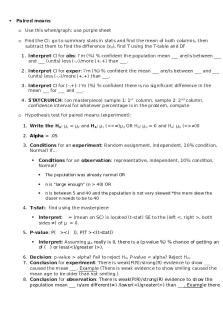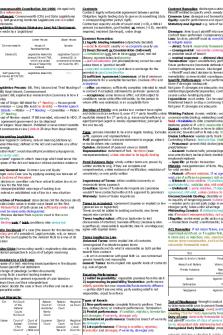Stats Cheat Sheet for Final Exam PDF

| Title | Stats Cheat Sheet for Final Exam |
|---|---|
| Author | Zoe Taylor |
| Course | Introduction to Psychological Design and Statistics |
| Institution | Macquarie University |
| Pages | 9 |
| File Size | 938.3 KB |
| File Type | |
| Total Downloads | 86 |
| Total Views | 503 |
Summary
Stats Cheat SheetPearsons Correlation Correlation is a numerical summary that shows the strength and direction of the linear relationship between 2 numerical variables Scatterplot Correlation coefficient (r) ranges from -1 to +1. Values closer to 0 - weaker correlation Values closer to +/-1 - strong...
Description
Wednesday, 3 November 2021
Stats Cheat Sheet
Pearsons Correlation - Correlation is a numerical summary that shows the strength and direction of the linear relationship between 2 numerical variables
Scatterplot - Correlation coefficient (r) ranges from -1.00 to +1.00 - Values closer to 0 - weaker correlation - Values closer to +/-1 - stronger correlation
P-Value > 0.05 we fail to reject the null hypothesis - accept null - swilk and Levene’s we want above 0.05 so we can run it < 0.05 we reject the null hypothesis no difference between means and there is no significant difference
In general - 0-0.10 = very weak to no relationship - 0.10-0.30 = weak relationship - 0.30-0.50 = moderate relationship - 0.50-1 = strong relationship - the more scatter/variability (spread out, no pattern) = the correlation is weaker
Cause and Effect: Distinction between - two things being related vs one thing causing the other Criteria for a cause and effect (causal) relationship: 1. Covariance rule: must be a relationship 2. Temporal precedence: the cause must precede the effect 3. Internal validity: exclude other potential causes of the effect
4
Normal Distribution - bell shaped distribution - has an unlimited range - The height and width of the “bell” depends on s, the standard deviation. - The “bell’s” position along the horizontal axis depends on m, its mean. Independent (IV): use to predict or explain or cause a change in the outcome Dependent (DV): dependent on independent variable - outcome Empirical science: knowledge about behaviour that’s been tested and confirmed via scientific methods Empirical research can either use: - Quantitative research methods: data gathered is numeric - Qualitative research methods: data gathered is descriptive 5
Wednesday, 3 November 2021
Non Experimental Non experimental studies are used when: - RQ’s/hypotheses don’t specify cause and effect relationships - Phenomena can’t be manipulated (practically and/or ethically) - External validity is more important than internal Types of Non-Experimental Methods: 1. Single variable research - studying one variable - Descriptive statistics and one-sample tests can be used for this 2. Correlational research: no (or minimal) interference, measuring things that already exist
- eg. Do Psychology students have higher self-reported science aptitude than Philosophy students? 3. Quasi-experimental research: looks a bit experimental but not properly experimental
- eg. Do Psychology students perform better in lab science skills test than Philosophy students? Two specific kinds of non-experimental RQ’s/hypotheses: 1. Group comparison (tested with independent samples t-tests) - is there a difference between the 2 groups? - they have 1 categorical IV & 1 numeric DV - they can also have a categorial DV 2. Correlation RQs/hypotheses (tested with correlational analyses) - is there a relationship between the 2 groups? - they have 2 numeric variables
6
Wednesday, 3 November 2021
Experimental Experimental Methods - researcher has control over the IV: eg: - What the conditions/groups are - Who is in what group To maximise internal validity - we use experimental methods Types of Experimental Methods 1. Between-subjects (independent groups) design - tested with independent sample t-tests - distinct independent groups - random allocation - either comparing two unique groups/interventions/conditions, or comparing one thing (e.g. intervention) against a control group 2. Within subjects (related group comparison) - tested with paired samples t-test Eg: Does condition A cause a different score of Y than condition B? - still have a “group” (“condition” variable) - Same group of people experiencing all conditions - ALL participants do/experience ALL conditions - Same control as between subjects - but better - only need half the amount of people - Less variation/error in scores - scores are more related, cause they’re from the same people
7
Wednesday, 3 November 2021
Mixed Methods Empirical research: - quantitative research methods: data = numeric - qualitative research methods: data = descriptive - or be mixed method study = combination of both
- Quantitative = restricting response (eg. Multiple choice) - Qualitative = free, open ended responses Most qualitative study methods: 1. interviews: one on one convo, often with back and forth - Structured: scripted - Unstructured: general questions/convo - Semi-structured: starts with script, then lets it flow - Can’t be promoting people with words - avoiding response bias 2. Focus groups: small no. of people in a room together - individuals response can be affected by others responses - see intergroup processes 3. Online survey: open-ended questions Themes: noticing the % of people who: - mention the word cat - Mention the feeling positive - Mention another animal 8
Conducting Mixed Methods Study Either: - conducted in a single “study” eg. Survey with open ended questions or interview - Conducted in 2 parts - eg. Quant study (experiment, survey) then follow up interview - In psych mixed method studies - Qual part is often briefer than pure qual studies Purpose of mixed - brings different and complimentary info - allowing more exploration of a topic and approach to RQ Tools to summarise and build models for qualitative data Word cloud - picks out certain words in the response Sentiment analysis - program that picks out words to classify them into positive, neutral or negative
Replication/Reproducibility: reproduce and conduct the study multiple times with different samples. Helps see if the results are consistent, real and reliable Replication/Reproducibility crisis Concerns about credibility of findings in psychological science Meta-analaysis - summarises individual studies and results. Finds the average overall typical population effect. Reasons of replication issues: - questionable (bad) research practices eg. Only reporting some results - Luck/random chance and variability - Only positive results are published Best Practices - we want to find real human behaviour that’s reliable, consistence and predictable - Being more systematic helps - planning, conducting and reporting study properly Preregistration - formalise research question, method and analysis before doing the study. Publicly report it so you’re held accountable - peer reviewed before study - Preregistration minimises bias 9
Wednesday, 3 November 2021 Open Data, Open Code, Transparent Methods - disclosing all decisions that you ended up doing - Disclosing all analyses you conducted - Make it publicly available - This makes sure data is not selectively report Open Access Publications - publications available freely online - If papers haven’t been peer reviewed they might not be good quality Robust Statistical Methods - use methods of reducing the likelihood of making a type 1 error Replication - true findings should be replicable Best practice in Psychological Science Culture and WEIRD Psychology - empirical research is how we understand human behaviour - via participant samples - Sample = participants, population = general/broader group were researching - Location is not broadly representative of the world - WEIRD = western, educated, industrialised, rich and democratic - We need studies to be conducted in different countries, cultures and genders so we can compare and find differences...
Similar Free PDFs

Stats Cheat Sheet for Final Exam
- 9 Pages

Cheat sheet for stats
- 8 Pages

Exam 3 cheat sheet stats
- 4 Pages

Cheat sheet final exam
- 3 Pages

Final Exam Cheat Sheet
- 2 Pages

Stats Cheat Sheet 3
- 1 Pages

Stats Cheat Sheet
- 16 Pages

Stats 306 cheat sheet
- 38 Pages

Final Exam Cheat Sheet
- 4 Pages

Final Exam Cheat Sheet
- 2 Pages

Final Exam Cheat Sheet
- 7 Pages

Final Exam Cheat Sheet
- 2 Pages

Final Exam Cheat Sheet
- 2 Pages

Exam cheat sheet used for final
- 20 Pages

LLAW1001 Final Exam Cheat Sheet
- 12 Pages
Popular Institutions
- Tinajero National High School - Annex
- Politeknik Caltex Riau
- Yokohama City University
- SGT University
- University of Al-Qadisiyah
- Divine Word College of Vigan
- Techniek College Rotterdam
- Universidade de Santiago
- Universiti Teknologi MARA Cawangan Johor Kampus Pasir Gudang
- Poltekkes Kemenkes Yogyakarta
- Baguio City National High School
- Colegio san marcos
- preparatoria uno
- Centro de Bachillerato Tecnológico Industrial y de Servicios No. 107
- Dalian Maritime University
- Quang Trung Secondary School
- Colegio Tecnológico en Informática
- Corporación Regional de Educación Superior
- Grupo CEDVA
- Dar Al Uloom University
- Centro de Estudios Preuniversitarios de la Universidad Nacional de Ingeniería
- 上智大学
- Aakash International School, Nuna Majara
- San Felipe Neri Catholic School
- Kang Chiao International School - New Taipei City
- Misamis Occidental National High School
- Institución Educativa Escuela Normal Juan Ladrilleros
- Kolehiyo ng Pantukan
- Batanes State College
- Instituto Continental
- Sekolah Menengah Kejuruan Kesehatan Kaltara (Tarakan)
- Colegio de La Inmaculada Concepcion - Cebu
